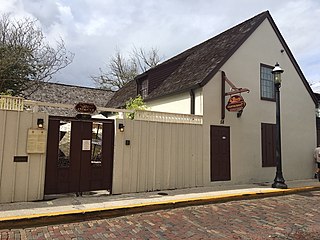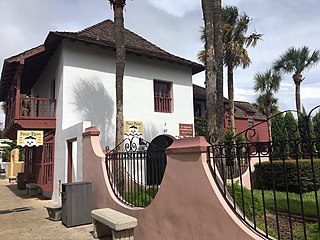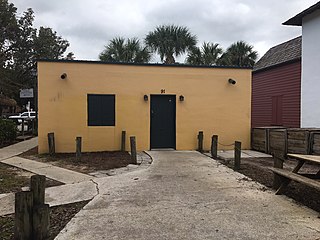
The Benet Store is located at 62 St. George Street, St. Augustine, Florida. The building is within the territory of the St. Augustine Town Plan Historic District.

The Benet Store is located at 62 St. George Street, St. Augustine, Florida. The building is within the territory of the St. Augustine Town Plan Historic District.
The first documented structure at this site appears on a 1765 map of the town. Later, a map of 1788 describes the house on this lot as a house of "wattle and daub in fair condition," owned by Matias Pons. It remained in his possession until he died in 1817, when his will described the property as a "stone and wood house with a store of victuals and provisions situated on St. George Street that goes to the Land Gate [present day City Gate] with its corresponding lot." [1] The property continued in the hands of his heirs until Peter Benet purchased it in 1839.
Pedro Benet (widely known as "The King of the Minorcans" after the distinctive ethnic group that settled in St. Augustine in 1777) and his wife, Juana Hernández, had ten children, among whom was Joseph Ravina Benet who later assisted in store operations. Pedro Benet's application for leave to remove his retail liquor shop from the southeast (the current reconstructed Benet House) to the southwest corner of St. George and Cuna Streets is recorded in the City Council Minute Book of October 13, 1840.
Before Pedro Benet purchased 62 St. George Street from the Pons heirs, Benet operated his own store on the ground floor of his own house across the street, as evidenced through taxes he paid on stock at $16 per year for shop licenses. After Pedro Benet died in 1870, his son Joseph Ravina Benet held occupational licenses from 1871-1883 on the house. The licenses were usually listed for keeping a store, or for selling goods, wares, and merchandise. In 1872 Joseph Ravina Benet was able to procure a license to sell wine and malt liquors, and in 1882-1883 he was able to sell tobacco and cigars.
The general store remained in existence until the late 19th century, when a notice in an 1887 newspaper appeared ordering the sale of Pedro Benet's property.
The name Benet later became world-famous because of the writings of brothers Stephen Vincent Benet and William Rose Benet (both Pulitzer Prizewinning poets) and their sister Laura Benet, also a widely published author. The literary Benet siblings were the great-grandchildren of Pedro Benet and the grandchildren of Brigadier General Stephen Vincent Benet, the first West Point appointee from the new state of Florida in 1845 and a trusted advisor to Abraham Lincoln during the Civil War. A building at West Point is named in honor of General Benet. All three of the literary Benets spent time in St. Augustine in the 1940s.
The old Benet store was demolished on August 13, 1903, before Bernard A. Masters built a new building on the site.
In 1967, the Historic St. Augustine Preservation Board began reconstructing a building on the old foundations of the old Benet store using early photographs, historic research, and recollections of two surviving members of the Benet family. During the era of San Agustín Antiguo, a living history museum running the length of St. George Street, the Benet store was on display as a craft store and museum. It was reconstructed as a 19th century general store; sausage stuffers, a cabbage shredder, an auger, hand wrought shears, and tongs hung from the ceiling. There were barrels of food throughout the store and announcements for ship arrivals into the port of St. Augustine lined the walls.
Today, the Benet store is retail space occupied by a jewelry store called J. R. Benet. The company, founded in 1979, makes handcrafted jewelry and gifts. [2]

The St Augustine Town Plan Historic District is a U.S. National Historic Landmark District encompassing the colonial heart of the city. It substantially encompasses the street plan of the city as contained within the bounds of walls built between the 16th and early 19th centuries. The district is bounded by Cordova, Orange, and St. Francis Streets, and Matanzas Bay. It was designated a National Historic Landmark in 1970, although its boundaries were not formally defined until 1986.

Ximenez-Fatio House Museum is one of the best-preserved and most authentic Second Spanish Period (1783-1821) residential buildings in St. Augustine, Florida. In 1973, it was added to the National Register of Historic Places. It was designated a Florida Heritage Landmark in 2012.

Government House, also known as Governor's House, is located at 48 King Street in St. Augustine, Florida, adjacent to the Plaza de la Constitución. The building, constructed of coquina, served as the governor's official residence from c. 1710 during the First Spanish Period (1565–1763), throughout the British Period (1763–1784), and until 1812 in the Second Spanish Period (1784–1821). Governor Gonzalo Méndez de Canzo was the first governor to build his residence on the present Government House site in 1598.

The Oliveros House is located at 59 St. George Street, St. Augustine, Florida. It was built of coquina during the Second Spanish Period in Florida (1565-1763). Today it is a reconstructed building, standing on original foundations which were unearthed during archaeological excavations.

The Wells Print Shop was located at 27 Cuna Street in St. Augustine, Florida. It operated as part of the Historic St. Augustine Preservation Board's 18th century museum village, San Agustín Antiguo, demonstrating the colonial printmaking process.

The William Watson House is located at 206 Charlotte Street in St. Augustine, Florida. It is a reconstructed property representing the architecture of St. Augustine's British Period (1763-1784).

The Historic St. Augustine Preservation Board (HSAPB) was a state agency in Florida that participated in the restoration and preservation of historic buildings in St. Augustine, Florida from 1959 to 1997. Created in 1959 by Governor LeRoy Collins, the agency acquired, restored, and preserved historic structures in St. Augustine until its abolishment by the State of Florida in June 1997.

The Ribera House is located at 22 St. George Street in St. Augustine, Florida. It is a reconstruction of the home that originally stood on this site during the First Spanish Period (1565-1764) of St. Augustine.

The Triay House is a historic property located at 31 St. George Street in St. Augustine, Florida. It is a reconstruction of the First Spanish Period structure that stood on the site.

The Arrivas House is located at 46 St. George Street, St. Augustine, Florida. It was the first completed restoration project of the Historic St. Augustine Preservation Board (HSAPB), and was named after early owner Don Raimundo de Arrivas.

The De Mesa-Sánchez House is located at 23 St. George Street in St. Augustine, Florida. It is a restoration of a home dating back to East Florida's First Spanish Period.

The Luciano de Herrera House is located at 58 Charlotte Street in St. Augustine, Florida. It is a reconstruction, depicting a house from St. Augustine's Second Spanish Period (1784–1821).

The Ortega House is located at 70 St. George Street in St. Augustine, Florida. It is a reconstructed home representing the architectural style of the First Spanish Period (1565-1763) in Florida.

The Marin-Hassett House is located at 97 St. George Street in St. Augustine, Florida. It is reconstructed on its foundations that date to St. Augustine's First Spanish Period.

The Santoyo House is located at 91 St. George Street, St. Augustine, Florida. It is a reconstruction of a First Spanish Period (1565-1763) house in Florida.

The Joaneda House is located at 57 Treasury Street in St. Augustine, Florida. It was restored to be an example of a Second Spanish Period (1784-1821) residence. It is one of the oldest buildings in Florida.

The Salcedo House and Kitchen are located at 42 and 42 1/2 St. George Street, in St. Augustine, Florida. They are reconstructions of 18th century structures that stood on these sites in St. Augustine's First Spanish Period (1565–1763).

The Pellicer-De Burgo House is located at 53 St. George Street in St. Augustine, Florida. It is a reconstruction of two connected houses built during the British Period (1763-1783) of East Florida.

The Casa del Hidalgo is located at 35 Hypolita Street, at the southeast intersection of Hypolita and St. George Streets in downtown St. Augustine, Florida. It was constructed in 1965 and housed the Spanish government's official exhibition and cultural center.

The Paredes-Dodge House is located at 54 St. George Street in St. Augustine, Florida. The one and a half story structure was built between 1803 and 1813, and is one of the only surviving colonial structures in St. Augustine.